Regional Differences in Agricultural Carbon Emissions in China: Measurement, Decomposition, and Influencing Factors
Abstract
1. Introduction
2. Literature Review
2.1. Measurement of ACE
2.2. Spatial Differences and Sources of ACE
2.3. Key Factors of ACE
3. Methodology and Data Measurement
3.1. Research Regional Division
3.2. Gini Coefficient Bidimensional Decomposition
3.3. Quadratic Assignment Procedure Analysis
3.4. ACE Measurement
3.5. Impact Factor Selection and Data Sources
3.6. Research Framework
4. Results and Discussion
4.1. Spatial and Temporal Characteristics
4.1.1. Regional Perspectives
4.1.2. Carbon Source Perspectives
4.2. Decomposition of Spatial Differences and Sources of ACE
4.2.1. Overall Differences
4.2.2. Spatial Differences from Regional Perspective
4.2.3. Spatial Differences from Carbon Source Perspective
4.2.4. Gini Coefficient Bidimensional Decomposition of Spatial Differences
4.3. QAP Analysis
4.3.1. Theoretical Frameworks
4.3.2. QAP Relevant Analysis
4.3.3. QAP Regression Analysis
5. Conclusions and Policy Implications
5.1. Conclusions
5.2. Policy Implications
5.3. Limitations
Author Contributions
Funding
Data Availability Statement
Conflicts of Interest
References
- Hough, A.M.; Derwent, R.G. Changes in the global concentration of tropospheric ozone due to human activities. Nature 1990, 344, 645–648. [Google Scholar]
- Meinshausen, M.; Meinshausen, N.; Hare, W.; Raper, S.C.; Frieler, K.; Knutti, R.; Frame, D.J.; Allen, M.R. Greenhouse-gas emission targets for limiting global warming to 2 °C. Nature 2009, 458, 1158–1162. [Google Scholar]
- Walther, G.; Post, E.; Convey, P.; Menzel, A.; Parmesan, C.; Beebee, T.J.; Fromentin, J.; Hoegh-Guldberg, O.; Bairlein, F. Ecological responses to recent climate change. Nature 2002, 416, 389–395. [Google Scholar] [PubMed]
- Gilles, E.; Ortiz, M.; Cadarso, M.; Monsalve, F.; Jiang, X. Opportunities for city carbon footprint reductions through imports source shifting: The case of Bogota. Resour. Conserv. Recy 2021, 172, 105684. [Google Scholar]
- Du, M.; Antunes, J.; Wanke, P.; Chen, Z. Ecological efficiency assessment under the construction of low-carbon city: A perspective of green technology innovation. J. Environ. Plan. Manag. 2022, 65, 1727–1752. [Google Scholar]
- Du, M.; Zhang, J.; Hou, X. Decarbonization like China: How does green finance reform and innovation enhance carbon emission efficiency? J. Environ. Manag. 2025, 376, 124331. [Google Scholar]
- Wang, X.; Yan, L. Driving factors and decoupling analysis of fossil fuel related-carbon dioxide emissions in China. Fuel 2022, 314, 122869. [Google Scholar] [CrossRef]
- Ren, X.; Ni, T. National shared responsibility mechanism for carbon reduction: Addressing resource imbalances from interprovincial flows of virtual water-energy-carbon. Appl. Geogr. 2025, 177, 103576. [Google Scholar]
- FAO. Agriculture, Forestry and Other Land Use Emissions by Sources and Removals by Sinks: 1990–2011 Analysis; FAO Statistics Division Working Paper Series; UN FAO: Rome, Italy, 2014. [Google Scholar]
- Nayak, D.; Saetnan, E.; Cheng, K.; Wang, W.; Koslowski, F.; Cheng, Y.; Zhu, W.; Wang, J.; Liu, J.; Moran, D. Management opportunities to mitigate greenhouse gas emissions from Chinese agriculture. Agric. Ecosyst. Environ. 2015, 209, 108–124. [Google Scholar]
- Tan, S.; Xie, D.; Ni, J.; Chen, F.; Ni, C.; Shao, J.; Zhu, D.; Wang, S.; Lei, P.; Zhao, G. Characteristics and influencing factors of chemical fertilizer and pesticide applications by farmers in hilly and mountainous areas of southwest, China. Ecol. Indic. 2022, 143, 109346. [Google Scholar]
- Dong, H.; Liu, Y.; Zhao, Z.; Tan, X.; Managi, S. Carbon neutrality commitment for China: From vision to action. Sustain. Sci. 2022, 17, 1741–1755. [Google Scholar]
- Li, Q.; Chen, W.; Shi, H.; Zhang, S. Assessing the environmental impact of agricultural production structure transformation—Evidence from the non-grain production of cropland in China. Environ. Impact Assess. 2024, 106, 107489. [Google Scholar]
- Liu, M.; Yang, L. Spatial pattern of China’s agricultural carbon emission performance. Ecol. Indic. 2021, 133, 108345. [Google Scholar]
- Kennedy, A.C.; Smith, K.L. Soil microbial diversity and the sustainability of agricultural soils. Plant Soil 1995, 170, 75–86. [Google Scholar]
- West, T.O.; Marland, G. A synthesis of carbon sequestration, carbon emissions, and net carbon flux in agriculture: Comparing tillage practices in the United States. Agric. Ecosyst. Environ. 2002, 91, 217–232. [Google Scholar]
- Johnson, J.M.; Franzluebbers, A.J.; Weyers, S.L.; Reicosky, D.C. Agricultural opportunities to mitigate greenhouse gas emissions. Environ. Pollut. 2007, 150, 107–124. [Google Scholar] [CrossRef]
- Reay, D.S.; Davidson, E.A.; Smith, K.A.; Smith, P.; Melillo, J.M.; Dentener, F.; Crutzen, P.J. Global agriculture and nitrous oxide emissions. Nat. Clim. Chang. 2012, 2, 410–416. [Google Scholar]
- Guan, N.; Liu, L.; Dong, K.; Xie, M.; Du, Y. Agricultural mechanization, large-scale operation and agricultural carbon emissions. Cogent Food. Agric. 2023, 9, 2238430. [Google Scholar]
- Chen, Z.; Sarkar, A.; Rahman, A.; Li, X.; Xia, X. Exploring the drivers of green agricultural development (gad) in China: A spatial association network structure approaches. Land. Use Policy 2022, 112, 105827. [Google Scholar]
- Lin, B.; Zhu, J. Impact of China’s new-type urbanization on energy intensity: A city-level analysis. Energy Econ. 2021, 99, 105292. [Google Scholar]
- Liu, C.; Sun, W.; Li, P.; Zhang, L.; Li, M. Differential characteristics of carbon emission efficiency and coordinated emission reduction pathways under different stages of economic development: Evidence from the Yangtze River delta, China. J. Environ. Manag. 2023, 330, 117018. [Google Scholar] [CrossRef] [PubMed]
- Zhao, R.; Liu, Y.; Tian, M.; Ding, M.; Cao, L.; Zhang, Z.; Chuai, X.; Xiao, L.; Yao, L. Impacts of water and land resources exploitation on agricultural carbon emissions: The water-land-energy-carbon nexus. Land. Use Policy 2018, 72, 480–492. [Google Scholar] [CrossRef]
- He, Y.; Cheng, X.; Wang, F.; Cheng, Y. Spatial correlation of China’s agricultural greenhouse gas emissions: A technology spillover perspective. Nat. Hazards 2020, 104, 2561–2590. [Google Scholar] [CrossRef]
- Zhang, X.; Xie, Y.; Jiao, J.; Zhu, W.; Guo, Z.; Cao, X.; Liu, J.; Wei, W. How to accurately assess the spatial distribution of energy CO2 emissions? Based on POI and NPP-VIIRS comparison. J. Clean. Prod. 2023, 402, 136656. [Google Scholar] [CrossRef]
- Cui, Y.; Khan, S.U.; Deng, Y.; Zhao, M. Regional difference decomposition and its spatiotemporal dynamic evolution of Chinese agricultural carbon emission: Considering carbon sink effect. Environ. Sci. Pollut. Res. 2021, 28, 38909–38928. [Google Scholar] [CrossRef]
- Lin, B.; Fei, R. Regional differences of CO2 emissions performance in China’s agricultural sector: A Malmquist index approach. Eur. J. Agron. 2015, 70, 33–40. [Google Scholar] [CrossRef]
- Pan, X.; Guo, S. Decomposition analysis of regional differences in China’s carbon emissions based on socio-economic factors. Energy 2024, 303, 131932. [Google Scholar] [CrossRef]
- Hou, M.; Cui, X.; Xie, Y.; Lu, W.; Xi, Z. Synergistic emission reduction effect of pollution and carbon in China’s agricultural sector: Regional differences, dominant factors, and their spatial-temporal heterogeneity. Environ. Impact Assess. 2024, 106, 107543. [Google Scholar] [CrossRef]
- Han, J.; Qu, J.; Maraseni, T.N.; Xu, L.; Zeng, J.; Li, H. A critical assessment of provincial-level variation in agricultural GHG emissions in China. J. Environ. Manag. 2021, 296, 113190. [Google Scholar] [CrossRef]
- Qin, Q.; Yan, H.; Liu, J.; Chen, X.; Ye, B. China’s agricultural GHG emission efficiency: Regional disparity and spatial dynamic evolution. Environ. Geochem. Health 2020, 44, 2863–2879. [Google Scholar] [CrossRef]
- Cui, Y.; Khan, S.U.; Deng, Y.; Zhao, M. Spatiotemporal heterogeneity, convergence and its impact factors: Perspective of carbon emission intensity and carbon emission per capita considering carbon sink effect. Environ. Impact Assess. 2022, 92, 106699. [Google Scholar]
- Sarkar, S.F.; Poon, J.S.; Lepage, E.; Bilecki, L.; Girard, B. Enabling a sustainable and prosperous future through science and innovation in the bioeconomy at agriculture and agri-food Canada. New Biotechnol. 2018, 40, 70–75. [Google Scholar] [CrossRef] [PubMed]
- Zhang, L.; Pang, J.; Chen, X.; Lu, Z. Carbon emissions, energy consumption and economic growth: Evidence from the agricultural sector of China’s main grain-producing areas. Sci. Total Environ. 2019, 665, 1017–1025. [Google Scholar] [PubMed]
- Wei, Z.; Wei, K.; Liu, J.; Zhou, Y. The relationship between agricultural and animal husbandry economic development and carbon emissions in Henan Province, the analysis of factors affecting carbon emissions, and carbon emissions prediction. Mar. Pollut. Bull. 2023, 193, 115134. [Google Scholar]
- Han, H.; Zhong, Z.; Guo, Y.; Xi, F.; Liu, S. Coupling and decoupling effects of agricultural carbon emissions in China and their driving factors. Environ. Sci. Pollut. Res. 2018, 25, 25280–25293. [Google Scholar]
- Su, L.; Wang, Y.; Yu, F. Analysis of regional differences and spatial spillover effects of agricultural carbon emissions in China. Heliyon 2023, 9, e16752. [Google Scholar] [CrossRef]
- Lin, B.; Xu, B. Factors affecting CO2 emissions in China’s agriculture sector: A quantile regression. Renew. Sust. Energy Rev. 2018, 94, 15–27. [Google Scholar]
- Tian, Y.; Zhang, J.; He, Y. Research on spatial-temporal characteristics and driving factor of agricultural carbon emissions in China. J. Intege Agric. 2014, 13, 1393–1403. [Google Scholar]
- Huang, X.; Xu, X.; Wang, Q.; Zhang, L.; Gao, X.; Chen, L. Assessment of agricultural carbon emissions and their spatiotemporal changes in China, 1997–2016. Int. J. Env. ReS. Public Health 2019, 16, 3105. [Google Scholar]
- Wang, G.; Liao, M.; Jiang, J. Research on agricultural carbon emissions and regional carbon emissions reduction strategies in China. Sustainability 2020, 12, 2627. [Google Scholar] [CrossRef]
- Xiong, C.; Yang, D.; Xia, F.; Huo, J. Changes in agricultural carbon emissions and factors that influence agricultural carbon emissions based on different stages in Xinjiang, China. Sci. Rep. 2016, 6, 36912. [Google Scholar]
- Guo, H.; Fan, B.; Pan, C. Study on mechanisms underlying changes in agricultural carbon emissions: A case in Jilin Province, China, 1998–2018. Int. J. Environ. Res. Public Heal. 2021, 18, 919. [Google Scholar]
- Zwane, T.T.; Udimal, T.B.; Pakmoni, L. Examining the drivers of agricultural carbon emissions in Africa: An application of FMOLS and DOLS approaches. Environ. Sci. Pollut. Res. 2023, 30, 56542–56557. [Google Scholar] [CrossRef]
- Ismael, M.; Srouji, F.; Boutabba, M.A. Agricultural technologies and carbon emissions: Evidence from Jordanian economy. Environ. Sci. Pollut. Res. 2018, 25, 10867–10877. [Google Scholar]
- Mussard, S. The bidimensional decomposition of the gini ratio. A case study: Italy. Appl. Econ. Lett. 2004, 11, 503–505. [Google Scholar] [CrossRef]
- Mussini, M. A matrix approach to the Gini index decomposition by subgroup and by income source. Appl. Econ. 2013, 45, 2457–2468. [Google Scholar]
- Dagum, C. Decomposition and interpretation of Gini and the generalized entropy inequality measures. Statistica 1997, 57, 295–308. [Google Scholar]
- Fernandes, R.; Simon, H.A. A study of how individuals solve complex and ill-structured problems. Policy Sci. 1999, 32, 225–245. [Google Scholar]
- IPCC. Intergovernmental Panel on Climate Change (IPCC), IPCC Forth Assessment Report: Climate Change 2007 (ar4). 2007. Available online: www.Ipcc.ch-publications_and_data-publications_and_data_reports.shtml (accessed on 20 March 2025).
- Yan, X.; Yagi, K.; Akiyama, H.; Akimoto, H. Statistical analysis of the major variables controlling methane emission from rice fields. Glob. Change Biol. 2005, 11, 1131–1141. [Google Scholar]
- Shahbaz, M.; Loganathan, N.; Muzaffar, A.T.; Ahmed, K.; Jabran, M.A. How urbanization affects Co2 emissions in Malaysia? The application of STIRPAT model. Renew. Sustain. Energy Rev. 2016, 57, 83–93. [Google Scholar] [CrossRef]
- Xu, B.; Lin, B. Factors affecting co2 emissions in China’s agriculture sector: Evidence from geographically weighted regression model. Energy Policy 2017, 104, 404–414. [Google Scholar] [CrossRef]
- Dong, B.; Ma, X.; Zhang, Z.; Zhang, H.; Chen, R.; Song, Y.; Shen, M.; Xiang, R. Carbon emissions, the industrial structure and economic growth: Evidence from heterogeneous industries in China. Environ. Pollut. 2020, 262, 114322. [Google Scholar] [PubMed]
- Yang, H.; Wang, X.; Bin, P. Agriculture carbon-emission reduction and changing factors behind agricultural eco-efficiency growth in China. J. Clean. Prod. 2022, 334, 130193. [Google Scholar]
- Xiong, C.; Wang, G.; Xu, L. Spatial differentiation identification of influencing factors of agricultural carbon productivity at city level in Taihu lake basin, China. Sci. Total Environ. 2021, 800, 149610. [Google Scholar]
- Dyer, J.A.; Desjardins, R.L. Carbon dioxide emissions associated with the manufacturing of tractors and farm machinery in Canada. Biosyst. Eng. 2006, 93, 107–118. [Google Scholar] [CrossRef]
- Zhang, Y.; Yu, Z.; Zhang, J. Research on carbon emission differences decomposition and spatial heterogeneity pattern of China’s eight economic regions. Environ. Sci. Pollut. Res. 2022, 29, 29976–29992. [Google Scholar] [CrossRef] [PubMed]
- Luo, Y.; Long, X.; Wu, C.; Zhang, J. Decoupling CO2 emissions from economic growth in agricultural sector across 30 Chinese provinces from 1997 to 2014. J. Clean. Prod. 2017, 159, 220–228. [Google Scholar] [CrossRef]
- Jin, S.; Fang, Z. Zero growth of chemical fertilizer and pesticide use: China’s objectives, progress and challenges. J. Resour. Ecol. 2018, 9, 50–58. [Google Scholar]
- Long, H.; Zou, J.; Liu, Y. Differentiation of rural development driven by industrialization and urbanization in eastern coastal China. Habitat. Int. 2009, 33, 454–462. [Google Scholar] [CrossRef]
- Ahmad, S.; Li, C.; Dai, G.; Zhan, M.; Wang, J.; Pan, S.; Cao, C. Greenhouse gas emission from direct seeding paddy field under different rice tillage systems in central China. Soil Tillage Res. 2009, 106, 54–61. [Google Scholar] [CrossRef]
- Sun, X.; Zhou, Q.; Ren, W.; Li, X.; Ren, L. Spatial and temporal distribution of acetochlor in sediments and riparian soils of the Songhua river basin in northeastern China. J. Environ. Sci. 2011, 23, 1684–1690. [Google Scholar]
- Hu, R.; Cai, Y.; Chen, K.Z.; Huang, J. Effects of inclusive public agricultural extension service: Results from a policy reform experiment in western China. China Econ. Rev. 2012, 23, 962–974. [Google Scholar]
- Zheng, W.; Luo, B.; Hu, X. The determinants of farmers’ fertilizers and pesticides use behavior in China: An explanation based on label effect. J. Clean. Prod. 2020, 272, 123054. [Google Scholar]
- Du, Y.; Liu, H.; Huang, H.; Li, X. The carbon emission reduction effect of agricultural policy-Evidence from China. J. Clean. Prod. 2023, 406, 137005. [Google Scholar]
- Xiao, W.; Zhao, G. Agricultural land and rural-urban migration in China: A new pattern. Land. Use Policy 2018, 74, 142–150. [Google Scholar]
- Huang, J.; Yang, G. Understanding recent challenges and new food policy in China. Glob. Food Secur. 2017, 12, 119–126. [Google Scholar]
- Yan, H.; Liu, Q.; Zhang, H.; Wang, H.; Li, H.; Yang, L. Difference in the thermal response of the occupants living in northern and southern China. Energy Build. 2019, 204, 109475. [Google Scholar]
- Yang, H.; Li, X. Cultivated land and food supply in China. Land. Use Policy 2000, 17, 73–88. [Google Scholar]
- Li, Y.; Li, X.; Tan, M.; Wang, X.; Xin, L. The impact of cultivated land spatial shift on food crop production in China, 1990–2010. Land Degrad. Dev. 2018, 29, 1652–1659. [Google Scholar]
- Fang, H. Effect of soil conservation measures and slope on runoff, soil, TN, and TP losses from cultivated lands in northern China. Ecol. Indic. 2021, 126, 107677. [Google Scholar]
- Li, X.; Jiang, W.; Duan, D. Spatio-temporal analysis of irrigation water use coefficients in China. J. Environ. Manag. 2020, 262, 110242. [Google Scholar]
- Pandey, B.; Seto, K.C. Urbanization and agricultural land loss in India: Comparing satellite estimates with census data. J. Environ. Manag. 2015, 148, 53–66. [Google Scholar]
- Tang, Y.; Luan, X.; Sun, J.; Zhao, J.; Yin, Y.; Wang, Y.; Sun, S. Impact assessment of climate change and human activities on GHG emissions and agricultural water use. Agric. For. Meteorol. 2021, 296, 108218. [Google Scholar]
- Jiang, L.; Zhang, J.; Wang, H.H.; Zhang, L.; He, K. The impact of psychological factors on farmers’ intentions to reuse agricultural biomass waste for carbon emission abatement. J. Clean. Prod. 2018, 189, 797–804. [Google Scholar]
- Wang, R.; Zhang, Y.; Zou, C. How does agricultural specialization affect carbon emissions in China? J. Clean. Prod. 2022, 370, 133463. [Google Scholar]
- Borgatti, S.P.; Everett, M.G.; Freeman, L.C. Ucinet for windows: Software for social network analysis. Anal. Technol. 2002, 6, 12–15. [Google Scholar]
- Li, N.; Li, Y.; Biswas, A.; Wang, J.; Dong, H.; Chen, J.; Liu, C.; Fan, X. Impact of climate change and crop management on cotton phenology based on statistical analysis in the main-cotton-planting areas of China. J. Clean. Prod. 2021, 298, 126750. [Google Scholar]


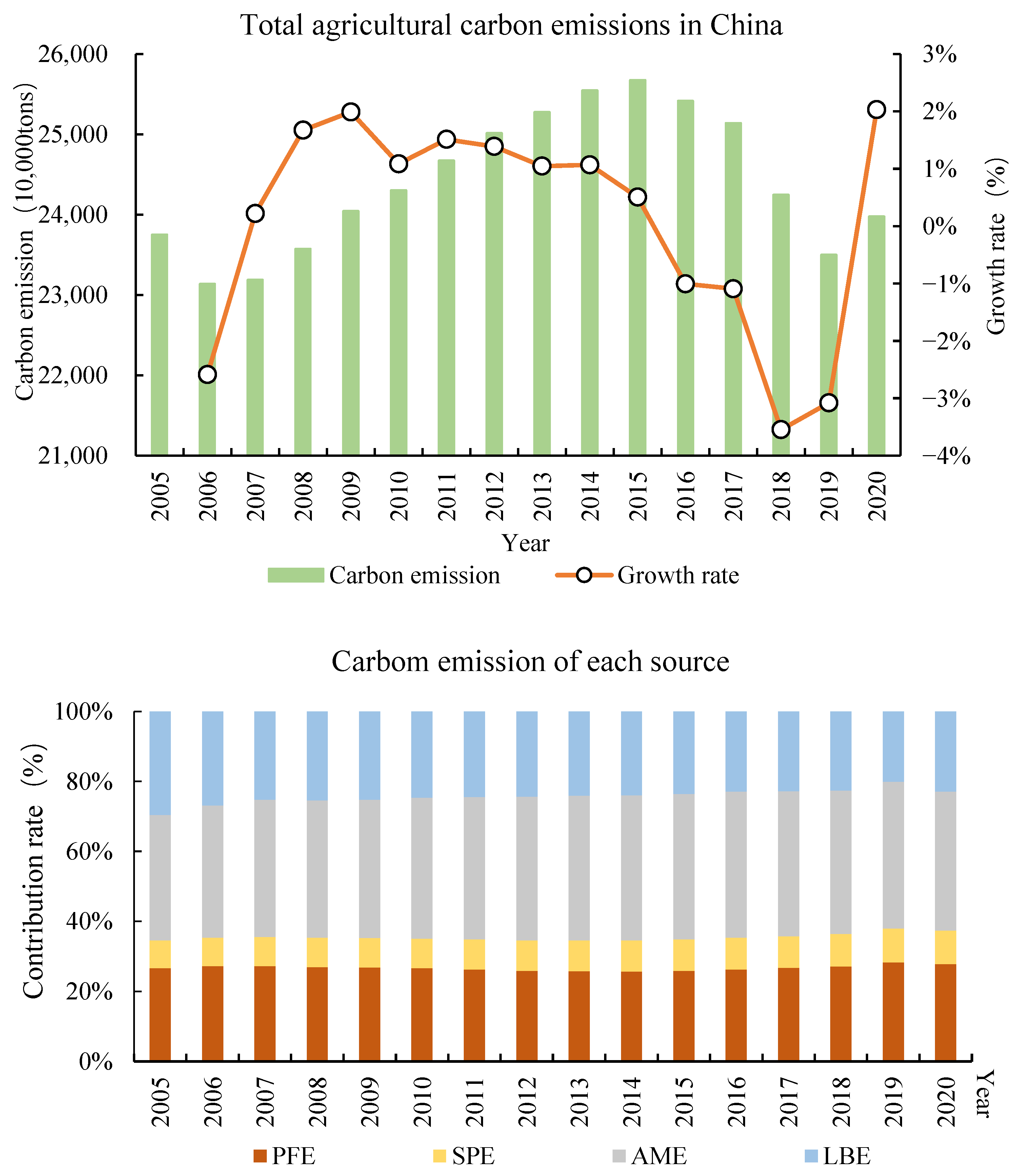
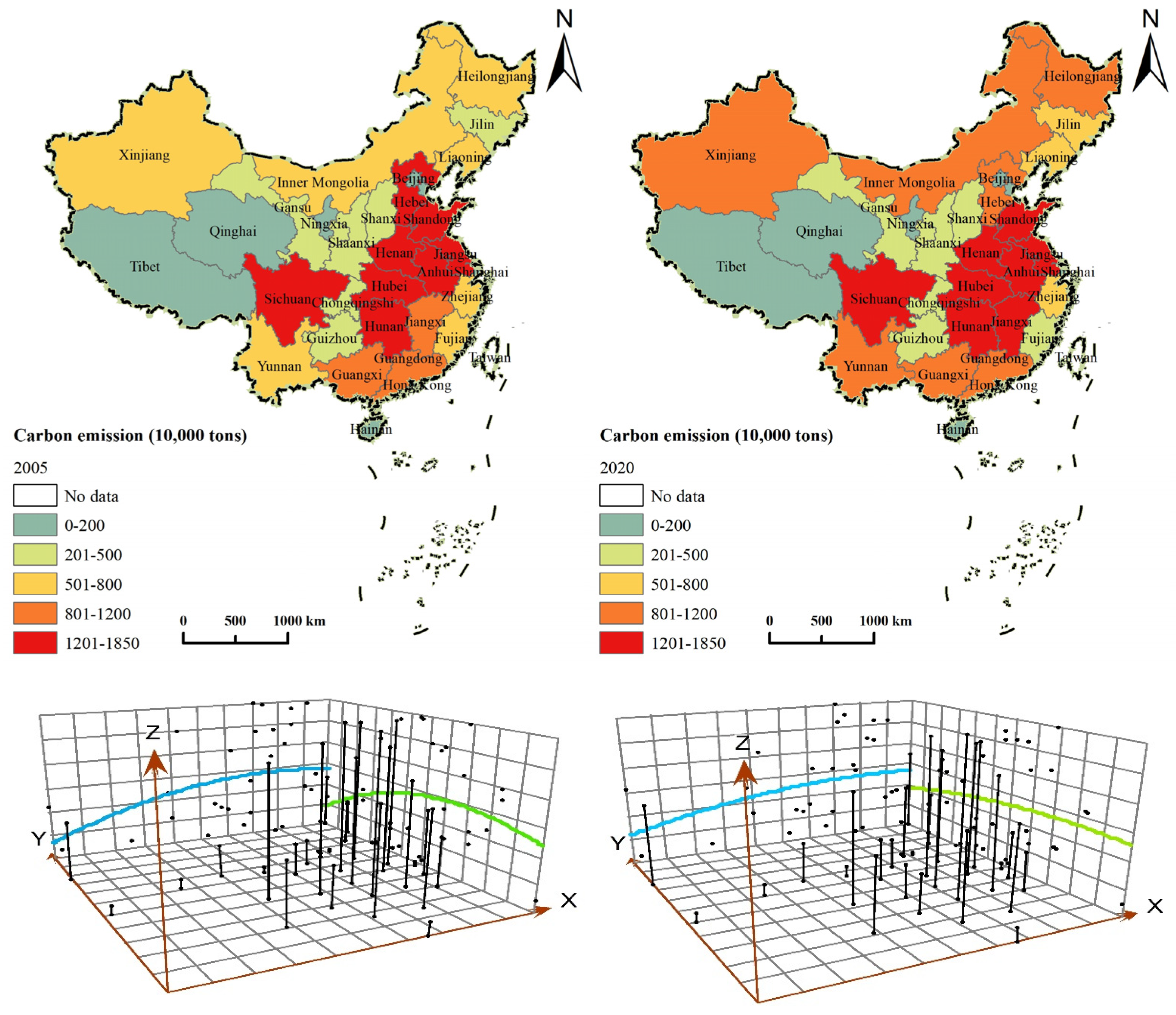
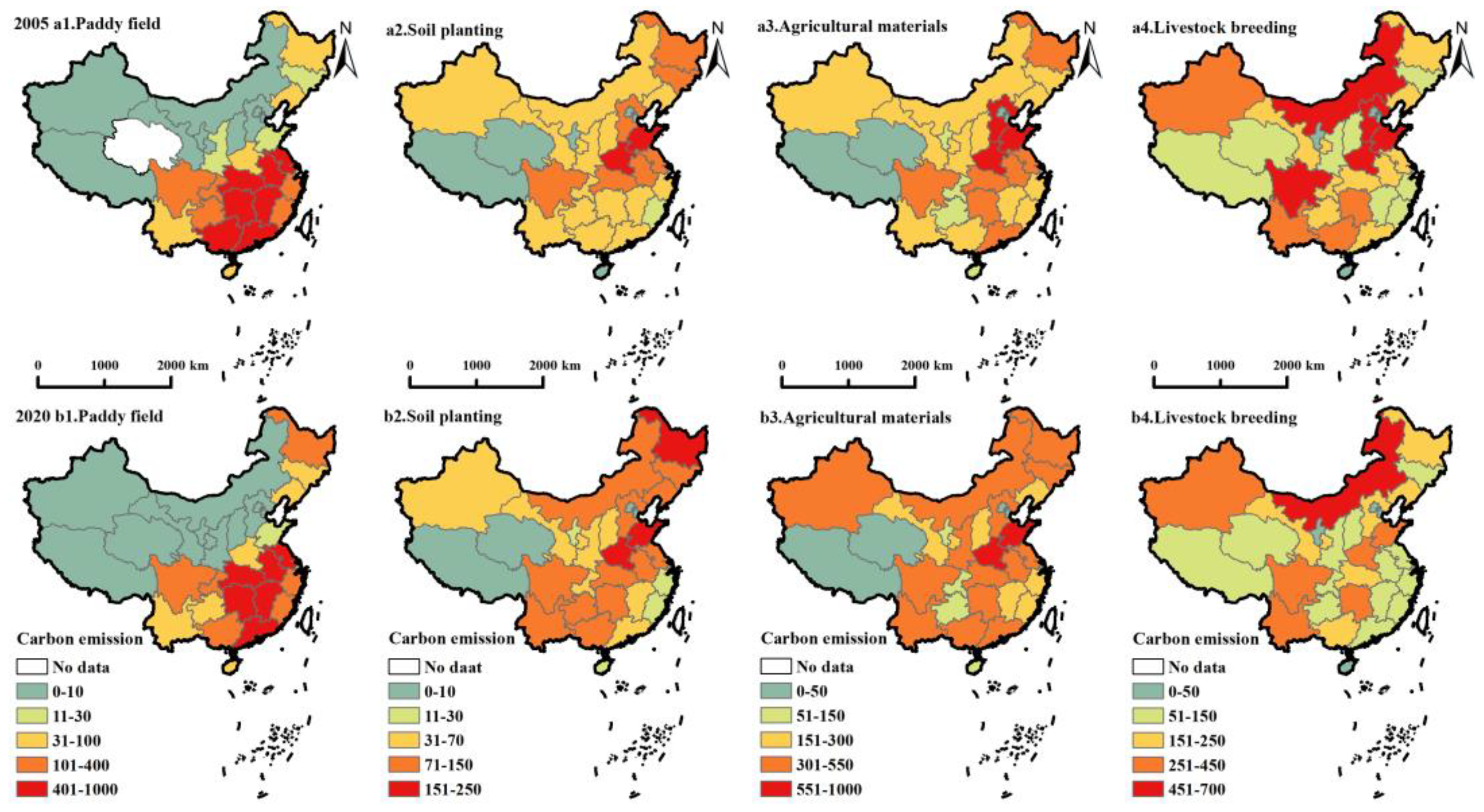
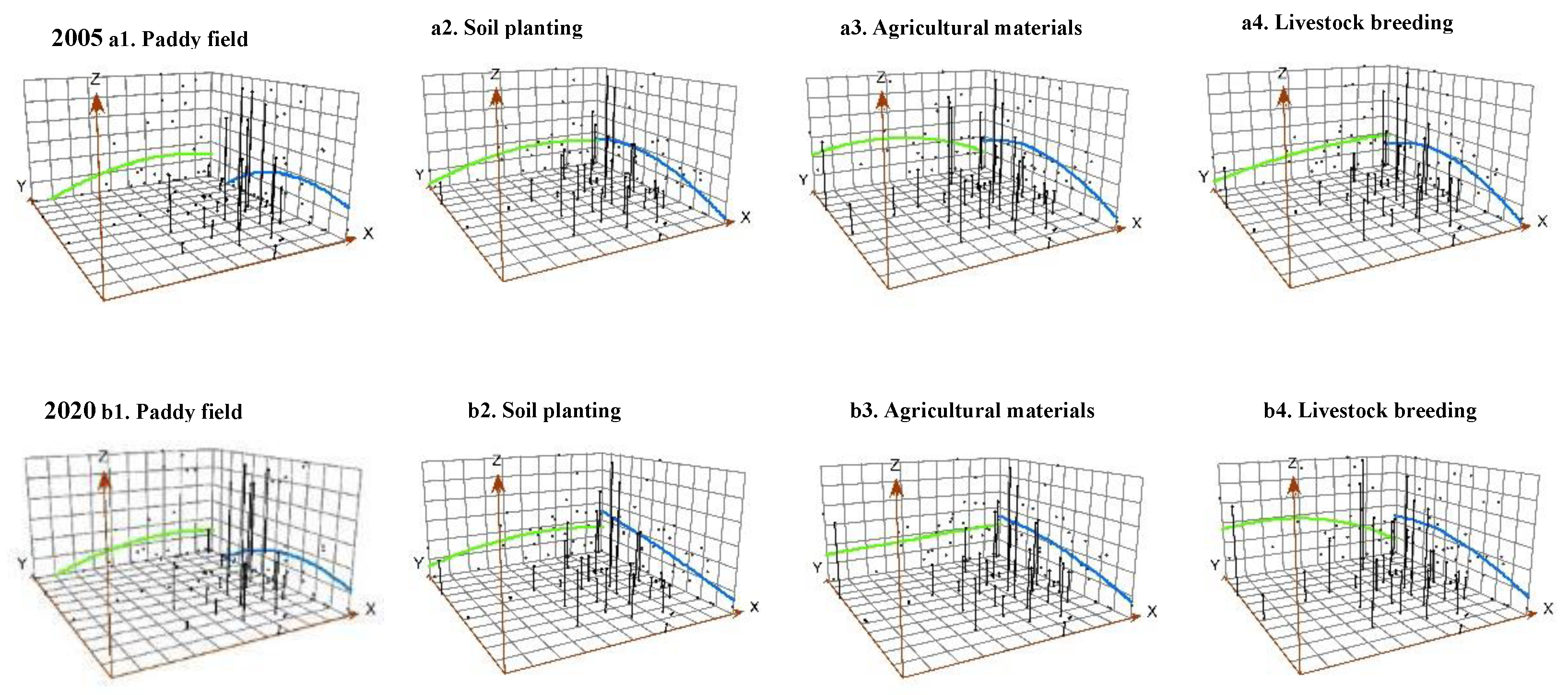
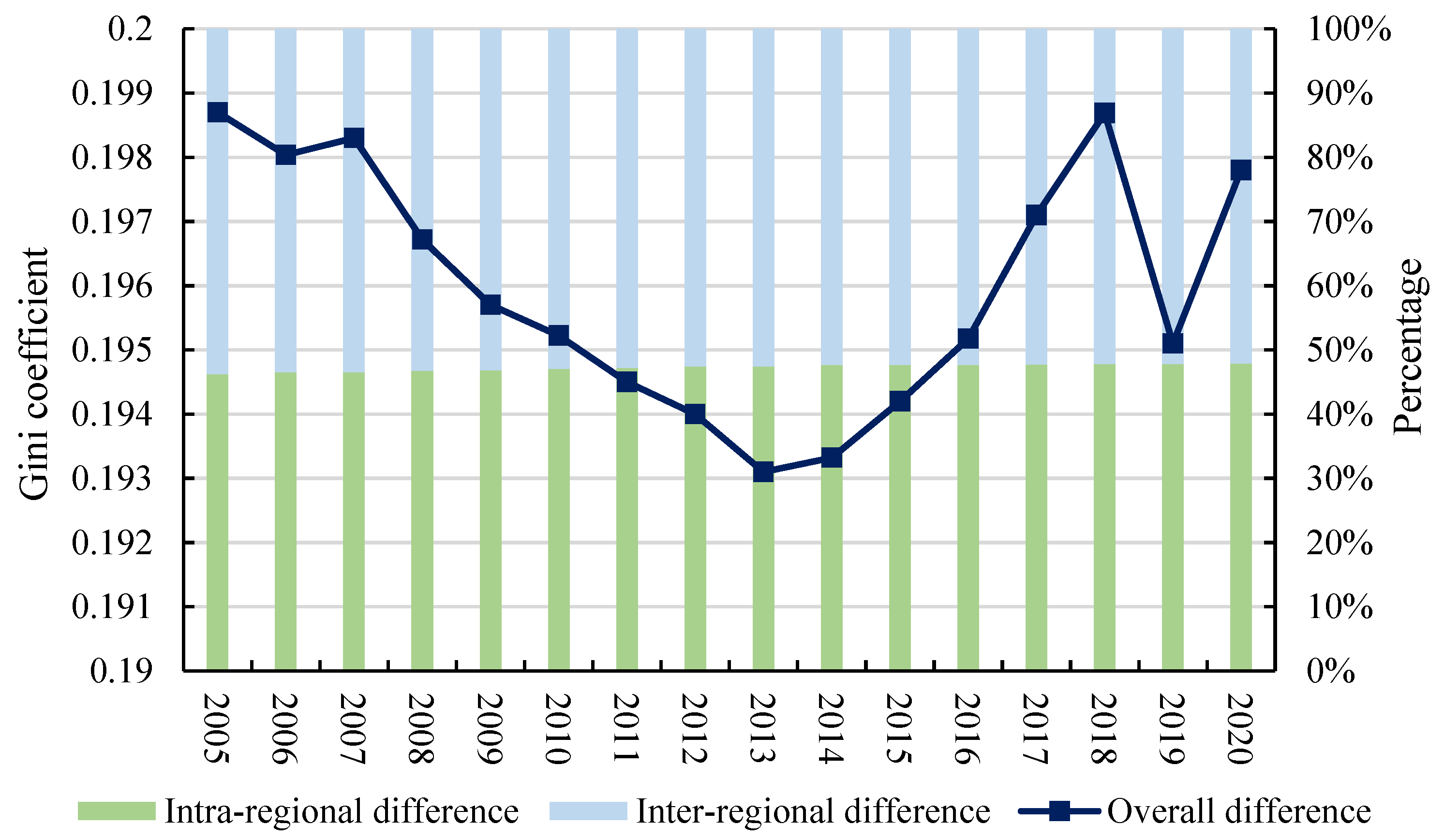

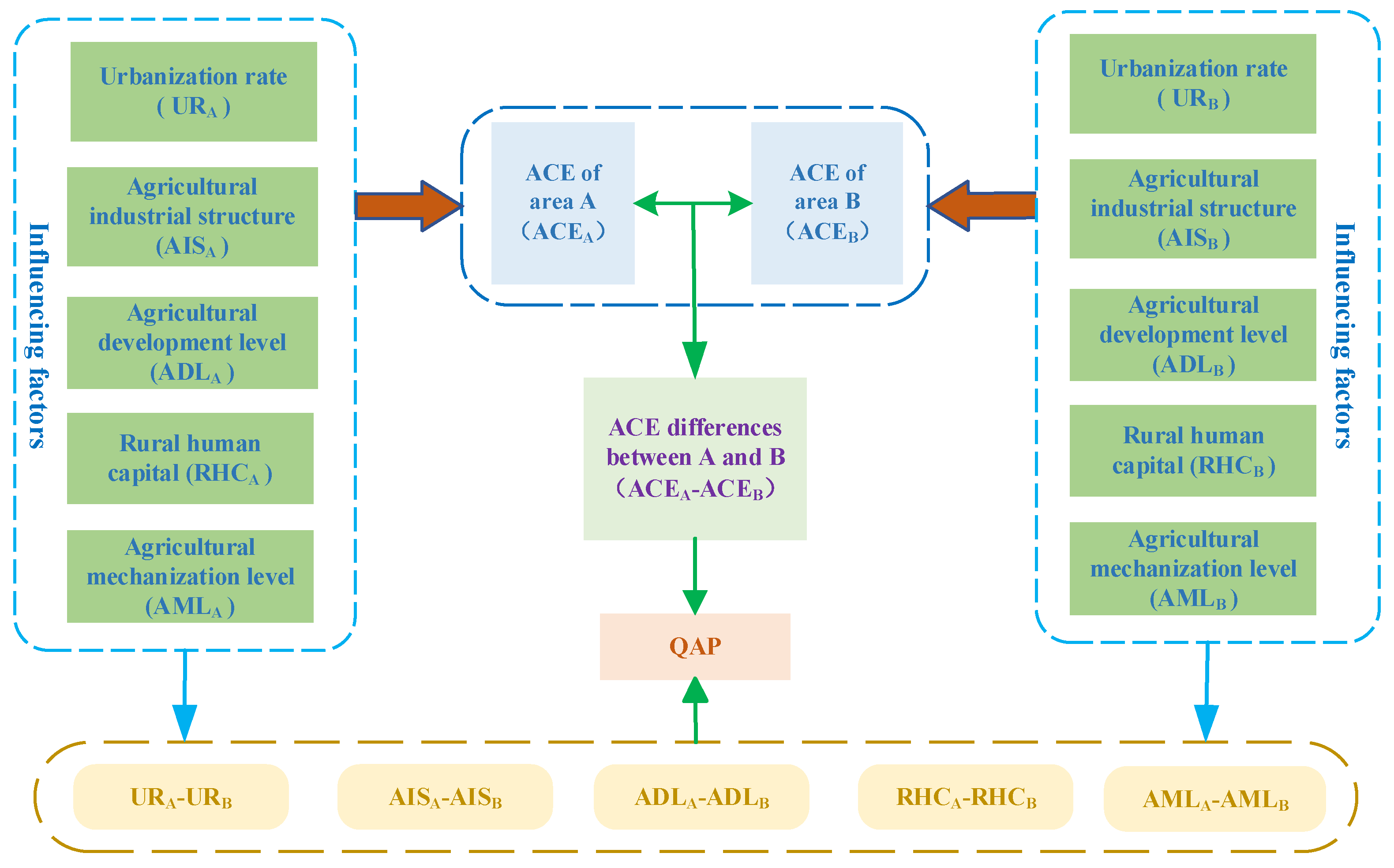
| Main Conclusions | Study Area | Time Span | ACE Measurement Dimension | Research Method | Author |
|---|---|---|---|---|---|
| China’s agricultural carbon emission performance (ACEP) increased by 1.5% from 2009 to 2019; Technological progress can improve ACEP; China’s ACEP has exhibited a spatial aggregation effect over the last 10 years. | Provincial data of China | 2009–2019 | Fertilizer, Pesticide, Agricultural film, Irrigation, Ploughing, Machinery, Diesel | Malmquist–Lemberger strategic balanced index, Spatial Moran’s index, Three convergence indices | Liu and Yang [14] |
| Agricultural pollution and carbon emissions (PCSRE) exhibits an increasing trend; Inter-regional differences are the main source of the overall differences in agricultural PCSRE. | National level of China | 2000–2021 | Fertilizer, Pesticides, Agricultural film, Agricultural diesel, Water for irrigation, Loss of agricultural tillage | Dagum Gini coefficient, Geodetector model, Panel geographically temporally weighted regression model | Hou et al. [29] |
| There are significant interprovincial variations in the total amount, structure, intensity, or per-capita level of agricultural GHG emissions; The magnitude of the effects varies by factor and also by province. | Provincial data of China | 1997–2017 | Agricultural inputs, Nitrification and de-nitrification of major crops, Rice paddies, Manure management | Geographically weighted regression model | Han et al. [30] |
| The amount of ACE was 291.1691 million t in 2010; There is an obvious ACE difference among regions; Compared with 1995, efficiency, labor, and structural factors cut carbon emissions by 65.78, 27.51, and 3.19%, respectively. | Provincial data of China | 1995–2010 | Agricultural materials inputs, Paddy field, Soil and livestock breeding | Logarithmic mean Divisia index model | Tian et al. [39] |
| The amount of agricultural carbon emissions in China generally increased, while the intensity of agricultural carbon emissions decreased; The amount and intensity of carbon emissions varied greatly among provinces; China’s ACE showed obvious spatial correlation. | Provincial data of China | 1997–2016 | Agricultural materials, Rice planting, Soil N2O, Livestock and poultry farming, Straw burning | Moran index | Huang et al. [40] |
| China’s total carbon emission in 2016 was 272.022 million tons; The total ACE of agricultural land use, rice cultivation, and livestock and poultry all increased from 2000 to 2016. | Provincial data of China | 2000–2016 | Agricultural land use, Rice cultivation, Ruminant animals | Coefficient of variation, Theil index | Wang et al. [41] |
| Xinjiang’s agricultural carbon emissions mainly come from agricultural land use and livestock farming; Xinjiang’s agriculture belongs to low-emission and high-efficiency agriculture, with a lower agricultural carbon emission intensity. | Data from one province in China | 1991–2014 | Agricultural land, Paddy field, Livestock farming | Logarithmic mean Divisia index | Xiong et al. [42] |
| During 1998–2018, the amount of ACE in Jilin Province increased; The characteristics of ACE in Jilin Province during the years is that of the low-intensity, high-density category. | Data from one province in China | 1998–2018 | Fertilizers, Agricultural diesel fuel, Agricultural plastic films, Pesticides, Land plowing, Irrigation, Paddy rice planting | Kaya identity, Logarithmic mean Divisia index | Guo et al. [43] |
| Agriculture growth promotes agricultural carbon emissions; There is a negative causal association between agricultural growth and agricultural carbon emissions in Africa. | Data of 34 African countries | 1990–2019 | Statistics of the Food and Agriculture Organisation and World Bank | Fully modified ordinary least squares model, Econometric model, Panel unit root tests | Zwane et al. [44] |
| There is bidirectional causality between the real income and carbon emissions; Fertilizers, crop and livestock production, land under cereal production, water access, agricultural value added, and the real income have an increasing effect on carbon emissions over the forecast period. | Annual data of Jordan | 1970–2014 | Machines, Fertilizers, Cereal land, Crop, Livestock | Cointegration test, Granger causality tests | Ismael et al. [45] |
| Crop Variety | N2O Emission Coefficient (kg ha−1) | Reference Source |
|---|---|---|
| Spring wheat | 0.4 | Huang et al. [40] |
| Winter wheat | 2.05 | Tian et al. [39] |
| Soybeans | 0.77 | Tian et al. [39] |
| Corn | 2.532 | Huang et al. [40] |
| Vegetables | 4.21 | Huang et al. [40] |
| Source | Carbon Emission Factor | Reference Source |
|---|---|---|
| Fertilizer | 0.8956 kg C·kg−1 | West and Marland [16] |
| Pesticides | 4.9341 kg C·kg−1 | West and Marland [16] |
| Agricultural Film | 5.18 kg C·kg−1 | IPCC [50] |
| Diesel | 0.5927 kg C·kg−1 | IPCC [50] |
| Irrigation | 266.48 kg C·hm−2 | West and Marland [16] |
| Source | Enteric Fermentation | Fecal Emissions | Source | Enteric Fermentation | Fecal Emissions | ||
|---|---|---|---|---|---|---|---|
| CH4 | CH4 | N2O | CH4 | CH4 | N2O | ||
| Cow | 61 | 18.00 | 1.00 | Mule | 10 | 18.00 | 1.00 |
| Buffalo | 55 | 2.00 | 1.34 | Camel | 46 | 2.00 | 1.34 |
| Cattle | 47 | 1.00 | 1.39 | Pig | 1 | 1.00 | 1.39 |
| Horse | 18 | 1.64 | 1.39 | Goat | 5 | 1.64 | 1.39 |
| Donkey | 10 | 0.90 | 1.39 | Sheep | 5 | 0.90 | 1.39 |
| Year | 2005 | 2007 | 2009 | 2011 | 2013 | 2015 | 2017 | 2019 | 2020 | |
|---|---|---|---|---|---|---|---|---|---|---|
| Gini coefficient | E-C | 0.031 | 0.032 | 0.033 | 0.034 | 0.034 | 0.035 | 0.036 | 0.036 | 0.037 |
| E-W | 0.049 | 0.048 | 0.045 | 0.044 | 0.044 | 0.043 | 0.0429 | 0.042 | 0.042 | |
| E-N | 0.011 | 0.011 | 0.010 | 0.010 | 0.010 | 0.010 | 0.0102 | 0.010 | 0.010 | |
| C-W | 0.040 | 0.041 | 0.042 | 0.042 | 0.041 | 0.042 | 0.0427 | 0.043 | 0.043 | |
| C-N | 0.010 | 0.009 | 0.010 | 0.009 | 0.009 | 0.009 | 0.0094 | 0.009 | 0.010 | |
| W-N | 0.008 | 0.008 | 0.008 | 0.009 | 0.009 | 0.009 | 0.0093 | 0.009 | 0.009 | |
| Inter-region | 0.149 | 0.149 | 0.148 | 0.148 | 0.147 | 0.148 | 0.150 | 0.149 | 0.151 | |
| Intra-region | 0.050 | 0.049 | 0.048 | 0.047 | 0.046 | 0.046 | 0.047 | 0.046 | 0.047 | |
| Contribution rate(%) | E-C | 15.802 | 16.145 | 16.863 | 17.224 | 17.504 | 17.859 | 18.163 | 18.555 | 18.595 |
| E-W | 24.811 | 24.218 | 23.199 | 22.776 | 22.527 | 22.131 | 21.766 | 21.425 | 21.425 | |
| E-N | 5.687 | 5.500 | 5.263 | 5.244 | 5.231 | 5.250 | 5.175 | 5.126 | 5.104 | |
| C-W | 20.030 | 20.636 | 21.308 | 21.440 | 21.388 | 21.462 | 21.664 | 21.938 | 21.829 | |
| C-N | 4.882 | 4.743 | 4.854 | 4.730 | 4.661 | 4.684 | 4.769 | 4.818 | 4.851 | |
| W-N | 3.825 | 4.137 | 4.241 | 4.473 | 4.661 | 4.735 | 4.718 | 4.716 | 4.699 | |
| Inter-region | 75.038 | 75.378 | 75.728 | 75.887 | 75.971 | 76.119 | 76.256 | 76.576 | 76.503 | |
| Intra-region | 24.962 | 24.622 | 24.272 | 24.113 | 24.029 | 23.881 | 23.744 | 23.424 | 23.497 | |
| Year | 2005 | 2007 | 2009 | 2011 | 2013 | 2015 | 2017 | 2019 | 2020 | |
|---|---|---|---|---|---|---|---|---|---|---|
| Coefficient | North | 0.052 | 0.052 | 0.051 | 0.051 | 0.051 | 0.052 | 0.052 | 0.055 | 0.052 |
| South | 0.040 | 0.041 | 0.040 | 0.041 | 0.041 | 0.041 | 0.0420 | 0.041 | 0.042 | |
| Intra-region | 0.092 | 0.092 | 0.092 | 0.092 | 0.092 | 0.093 | 0.094 | 0.093 | 0.095 | |
| Inter-region | 0.107 | 0.106 | 0.104 | 0.103 | 0.102 | 0.102 | 0.103 | 0.1020 | 0.103 | |
| Contribution Rate (%) | North | 26.271 | 25.969 | 25.768 | 25.717 | 25.667 | 25.919 | 26.271 | 26.120 | 26.371 |
| South | 20.030 | 20.483 | 20.332 | 20.483 | 20.483 | 20.634 | 21.087 | 20.785 | 21.288 | |
| Intra-region | 46.251 | 46.452 | 46.150 | 46.200 | 46.100 | 46.603 | 47.358 | 46.905 | 47.660 | |
| Inter-region | 53.749 | 53.347 | 52.340 | 51.686 | 51.082 | 51.132 | 51.837 | 51.283 | 51.887 | |
| Year | 2005 | 2010 | ||||||||
|---|---|---|---|---|---|---|---|---|---|---|
| PFE | SPE | AME | LBE | Total | PFE | SPE | AME | LBE | Total | |
| E-C | 5.737 | 1.208 | 4.831 | 4.026 | 15.806 | 7.633 | 1.178 | 5.174 | 3.125 | 17.059 |
| E-W | 6.794 | 1.966 | 10.367 | 5.737 | 24.811 | 5.994 | 1.998 | 10.348 | 4.559 | 22.951 |
| E-N | 1.611 | 0.403 | 2.466 | 1.208 | 5.687 | 1.332 | 0.512 | 2.510 | 0.922 | 5.277 |
| C-W | 10.015 | 1.208 | 5.939 | 2.869 | 20.030 | 11.578 | 1.230 | 6.814 | 1.793 | 21.414 |
| C-N | 2.869 | 0.151 | 1.057 | 0.856 | 4.885 | 3.026 | 0.103 | 1.078 | 0.615 | 4.764 |
| W-N | 1.007 | 0.302 | 1.208 | 1.309 | 3.825 | 1.127 | 0.512 | 1.844 | 0.922 | 4.355 |
| Inter-region | 28.032 | 5.234 | 25.818 | 15.954 | 75.038 | 30.635 | 5.536 | 27.715 | 11.937 | 75.820 |
| Intra-region | 6.744 | 1.912 | 8.858 | 7.448 | 24.962 | 6.404 | 2.049 | 9.631 | 6.096 | 24.180 |
| Year | 2015 | 2020 | ||||||||
| PFE | SPE | AME | LBE | Total | PFE | SPE | AME | LBE | Total | |
| E-C | 8.651 | 1.184 | 5.046 | 2.987 | 17.868 | 9.955 | 1.162 | 4.649 | 2.830 | 18.595 |
| E-W | 5.304 | 2.163 | 10.093 | 4.583 | 22.142 | 5.609 | 2.173 | 9.146 | 4.497 | 21.425 |
| E-N | 0.978 | 0.772 | 2.523 | 0.978 | 5.252 | 1.112 | 0.707 | 2.426 | 0.859 | 5.104 |
| C-W | 12.204 | 1.236 | 6.334 | 1.648 | 21.473 | 13.643 | 1.213 | 5.761 | 1.213 | 21.829 |
| C-N | 3.141 | 0.052 | 0.927 | 0.566 | 4.686 | 3.335 | 0.101 | 0.809 | 0.556 | 4.851 |
| W-N | 0.978 | 0.721 | 2.163 | 0.875 | 4.737 | 1.061 | 0.657 | 2.173 | 0.809 | 4.699 |
| Inter-region | 31.256 | 6.128 | 27.086 | 11.638 | 76.107 | 34.765 | 5.963 | 24.962 | 10.864 | 76.503 |
| Intra-region | 5.870 | 2.214 | 9.938 | 5.922 | 23.893 | 6.215 | 2.324 | 9.601 | 5.356 | 23.497 |
| Year | 2005 | 2010 | ||||||||
|---|---|---|---|---|---|---|---|---|---|---|
| PFE | SPE | AME | LBE | Total | PFE | SPE | AME | LBE | Total | |
| North | 6.391 | 2.416 | 10.770 | 6.643 | 26.220 | 7.889 | 2.408 | 11.168 | 4.764 | 26.230 |
| South | 8.052 | 1.107 | 4.932 | 5.939 | 20.030 | 8.248 | 1.383 | 6.148 | 5.072 | 20.850 |
| Intra-region | 14.444 | 3.523 | 15.702 | 12.582 | 46.251 | 16.086 | 3.791 | 17.316 | 9.836 | 47.080 |
| Inter-region | 20.332 | 3.624 | 18.973 | 10.820 | 53.749 | 20.902 | 3.791 | 20.030 | 8.197 | 52.920 |
| Year | 2015 | 2020 | ||||||||
| PFE | SPE | AME | LBE | Total | PFE | SPE | AME | LBE | Total | |
| North | 8.805 | 2.472 | 10.711 | 4.531 | 26.519 | 10.313 | 2.427 | 9.757 | 3.994 | 26.491 |
| South | 7.673 | 1.648 | 6.900 | 4.943 | 21.112 | 7.937 | 1.719 | 7.078 | 4.651 | 21.385 |
| Intra-region | 16.478 | 4.120 | 17.611 | 9.423 | 47.683 | 18.301 | 4.146 | 16.785 | 8.696 | 47.877 |
| Inter-region | 20.597 | 4.171 | 19.413 | 8.136 | 52.317 | 22.700 | 4.146 | 17.796 | 7.533 | 52.123 |
| Factors | Overall | Eastern Region | Central Region | Western Region | Northeast Region | Northern Region | Southern Region |
|---|---|---|---|---|---|---|---|
| UR | −0.207 * | −0.458 * | −0.168 | −0.082 | −0.484 | −0.258 | −0.158 |
| AIS | −0.035 | 0.124 | −0.774 ** | −0.409 ** | 0.956 | 0.091 | −0.410 * |
| ADL | 0.550 *** | 0.886 *** | 1.476 ** | 0.723 * | 0.891 | 0.740 *** | 0.176 |
| RHC | 0.688 *** | 0.848 *** | 0.771 *** | 0.588 ** | 0.917 | 0.769 *** | 0.583 *** |
| AML | 0.781 *** | 0.789 *** | 0.657 ** | 0.957 *** | 0.999 | 0.913 *** | 0.985 *** |
| Factors | Overall | Eastern Region | Central Region | Western Region | Northeast Region | Northern Region | Southern Region |
|---|---|---|---|---|---|---|---|
| UR | −0.320 | 0.268 | −0.167 | −0.204 | −0.009 | −0.331 ** | −0.209 |
| AIS | −0.325 ** | 0.243 * | −0.766 ** | −0.806 *** | 0.808 | −0.375 * | −0.419 * |
| ADL | 0.659 *** | 1.045 *** | 0.944 ** | 1.093 ** | −0.165 | 0.804 *** | 0.249 |
| RHC | 0.290 ** | 0.703 *** | 0.156 | −0.031 | 0.393 *** | −0.165 ** | −0.067 |
| AML | 0.584 *** | −0.231 | 0.651 * | 0.977 *** | 0.010 *** | 1.058 *** | 0.979 *** |
Disclaimer/Publisher’s Note: The statements, opinions and data contained in all publications are solely those of the individual author(s) and contributor(s) and not of MDPI and/or the editor(s). MDPI and/or the editor(s) disclaim responsibility for any injury to people or property resulting from any ideas, methods, instructions or products referred to in the content. |
© 2025 by the authors. Licensee MDPI, Basel, Switzerland. This article is an open access article distributed under the terms and conditions of the Creative Commons Attribution (CC BY) license (https://creativecommons.org/licenses/by/4.0/).
Share and Cite
Huang, J.; Lu, H.; Du, M. Regional Differences in Agricultural Carbon Emissions in China: Measurement, Decomposition, and Influencing Factors. Land 2025, 14, 682. https://doi.org/10.3390/land14040682
Huang J, Lu H, Du M. Regional Differences in Agricultural Carbon Emissions in China: Measurement, Decomposition, and Influencing Factors. Land. 2025; 14(4):682. https://doi.org/10.3390/land14040682
Chicago/Turabian StyleHuang, Jie, Hongyang Lu, and Minzhe Du. 2025. "Regional Differences in Agricultural Carbon Emissions in China: Measurement, Decomposition, and Influencing Factors" Land 14, no. 4: 682. https://doi.org/10.3390/land14040682
APA StyleHuang, J., Lu, H., & Du, M. (2025). Regional Differences in Agricultural Carbon Emissions in China: Measurement, Decomposition, and Influencing Factors. Land, 14(4), 682. https://doi.org/10.3390/land14040682








